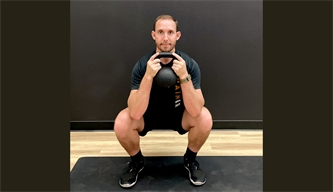24Jan
Three Exercises to Help Manage Crohn's
By: Nyaka Mwanza
Crohn's disease, one of the most common types of inflammatory bowel disease (IBD), is a chronic autoimmune condition that causes inflammation of the gastrointestinal (GI) tract. One symptom of Crohn’s disease is constipation. If IBD and constipation are a problem you’re experiencing, exercise can help strengthen the abdominal muscles and help get your bowels moving. In general, exercise is key to managing your IBD, maintaining your overall physical health, and improving your mental health — important aspects of living with a chronic condition like Crohn's.
According to the Centers for Disease Control and Prevention (CDC), adults should get about 150 minutes of moderate-intensity exercise per week, or 30 minutes a day five days a week. Exercise need not be a chore or a bore. In fact, you’re more likely to exercise regularly if you enjoy the physical activity you're engaged in. Try varying how and where you exercise to keep it more interesting for yourself. Here are three exercises to try.
Walking
Brisk walking is a great form of low-impact physical activity. Low impact exercise (which also includes cycling, swimming, or using an elliptical machine) gets the heart pumping with minimal risk of injury and joint strain. Regular aerobic exercise may help reduce disease activity and the frequency and intensity of Crohn's flares.
Walking is a great way to get outside. It can be done almost anywhere you are and can be done in different places to keep it interesting. Another bonus: you can bring your favorite four-legged furry friend along for the fun. If the weather isn’t conducive to outdoor walking, you can always walk around a mall, on a treadmill at In-Shape, or in your home.
Weight and Resistance Training
Resistance training increases the body’s strength by pushing, pulling, or lifting weights or another form of resistance (such as gravity or your own body weight). Resistance training can involve weight lifting (either free weights, weight machines, or a studio class based around strength like BODYPUMP or M7: Strength) and strength training exercises such as sit-ups and squats.
There are several different ways to strength train, regardless of your level of fitness or strength. Resistance training can happen in your home or at the gym. You can purchase special equipment such as resistance bands, or you can use everyday objects in your house such as a towel or scarf to create similar resistance. You can also go equipment-free by just using the combination of your body and gravity through exercises like push-ups and crunches. There are also loads of great strength training apps with guided workouts to help keep your exercising varied, engaging, and effective.
Yoga
Yoga is a form of low-impact exercise that builds strength and improves flexibility while reducing stress and improving mental health, which may help control flare-ups.
One of the greatest things about yoga is that just about anyone can do it, no matter their current fitness level, weight, or experience. You can find yoga at your local health club, participate in yoga classes online, or map out your own self-guided yoga journey.
Choose a Workout that Works for You
Generally, high-intensity or strenuous exercise is not recommended for people with IBD. Strenuous activity can cause or worsen inflammation and may hinder proper functioning of the immune system.
Everyone’s Crohn's disease affects them differently. If exercise causes you pain or discomfort, or if your symptoms make it hard for you to work out, it’s okay to do less or to take a day off. Listen to your body. Everyone’s physical abilities are different. Discuss your exercise plan with your healthcare provider, who can recommend the best personalized regimen for you.
References
- Crohn's Disease and Constipation: Treatments and Causes | MyCrohnsAndColitisTeam
- Exercise — Crohn's and Colitis Foundation
- Strength and Resistance Training Exercise — AHA
- Crohn's Disease: Diagnosis and Treatment
- Exercise and inflammatory bowel disease — Canadian Journal of Gastroenterology
About the Author
Related

You might not know it, but almost everything you’re consuming contains a certain amount of sugar. F...
Read More >

As a part of the In-Shape family, we know you work hard to stay active. But did you know there’s a ...
Read More >

If you've been hitting the gym for a while, you may have heard of the "mind-muscle connecti...
Read More >

Are you looking for a lower body workout that will challenge your endurance and strength while also ...
Read More >

When it comes to getting lunch on the go, we’re all looking for the same things: something healthy,...
Read More >

VTL™ Trainer Andrew is back with a new kettlebell workout you can complete in just ten minutes. Thi...
Read More >